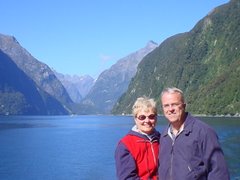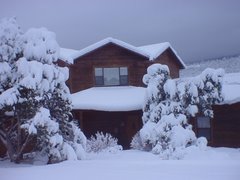
Friday we did our best to do Key West. We started by driving down to the site on Key West that is the southernmost point in the continental US. Got the picture to prove it.

Susie loves these geographical extremities. In New Zealand she got misty-eyed when we were at the north tip of the North Island (thinking how far it was over that ocean to home and family) and at the south end of the South Island (again moved to ponder our global remoteness). Right after the above picture we had breakfast at the southernmost beach café in the US, right across the street from the southernmost hotel in the US.
On the adjacent street two houses had plaques claiming to be the southernmost house in the US. We learned later that the house below, now a B&B, was built first and the plaque went up on the wall; some time later a neighbor extended his house slightly more to the south and put up his own plaque. The first left his plaque up. Later in the day we drove past a sign that proclaimed the southernmost RE-MAX office in the US. Nice touch of humor. And so it goes.

Next we caught the tourist trolley for a tour around KW. First trolley we got on was also boarded by a large family group, celebrating Howard who was 90 in ’09 (duly noted on the entourage's matching t-shirts). Many family members spanning four generations. Trouble was a couple of the youngest generation wouldn’t stop talking over the driver’s words, in spite of attempts to shush them, so at the first stop we got off and caught the next trolley – they run every half hour. This one - we lucked out - had a comedian/historian driver and a smaller, quieter set of passengers (though there were a couple of non-English speakers who sometimes talked over the driver). And a smaller, quieter set of riders. Our route took us by the “southernmost point in the US” at which point our guide turned on his loudspeaker and announced that we were on the southernmost trolley in the US and that the tourists at the marker were the southernmost tourists in the US.
You may remember this story: Back in 1982 Immigration set up a blockade just north of the northernmost key and began subjecting all northbound travelers to a careful inspection. The result was long lines and lots of irritation of returning tourists and a drop-off of the tourism lifeblood. Key Westers figured that if they were outside of the border-crossing, they must not be part of the US (despite being southernmost US in so many ways), so they formalized the situation by declaring their independence, calling themselves the Conch Republic, then, after one minute of independence, surrendering to the US (there is a Navy base on the island) and asking for foreign aid. (You should read the link - it's a hoot.) The blockade was soon halted. To this day you can buy Conch Republic t-shirts. The event is annually celebrated by drag (queen) races down the main street of town. Incidentally, conch is pronounced conk.
US 1 starts in Key West – there is a mile zero sign (the southernmost highway sign in the US) where it starts. Driver told us that if he drove 2000 plus miles up that highway, we would be in Maine and he would have a load of (peeved) passengers. He had a lot of witticisms along the same line but I didn't take notes and have mercifully forgotten most of them.
Across the Keys, US 1 is called the Overseas Highway. There are 42 bridges along the way. Here's a picture of one of them -seen from where we stopped for lunch on the way down.

The first overseas route to Key West, though, was the Overseas Railroad. It was built in the early 1900s, completed in 1912, by a man named Flagler, who had partnered with Rockefeller in Standard Oil. (Flagler also has his own county, is known as the Father of Miami, and you see many references to Flagler throughout the state.) The motivation was that the closest deep water US port to the newly completed Panama Canal was at Key West. The RR was in use until 1935 when a hurricane heavily damaged it and repairs could not be financed at that time. Many of the RR bridges are still in place, but they’ve been converted for recreational use. In some cases a few sections have been removed to permit sailboats to pass through.
The tour went by Hemingway's house The driver's story was that to build the brick wall in front and a patio on the grounds Hemingway took the bricks out of a local street. When the city went looking for their missing bricks, they were not hard to find. The linked website says only that Hemingway bought the bricks from the city. Any Hemingway scholars out there who know the real story?

After the tour we walked the shops a bit. Any resemblance between these two lovelies is purely accidental.

Somewhere on the streets we encountered an honest panhandler: Would you give me a dollar to buy beer. I promise I won’t waste it on food.
I mentioned earlier that sunset is celebrated on Key West. People gather at the waterfront on Mallory Square and numerous charter boats can take you on a sunset cruise. We joined the throngs on Mallory Square Friday evening. Jugglers, acrobats, and a street preacher provided entertainment as we waited. This guy was quite the showman.

Then we all faced the sun and waited. There was a round of applause as the sun disappeared into the Caribbean, then everybody turned their backs and left. I have to say that my camera put more color into this picture than I saw with my eye. Don't know whether to credit the camera's software or fault my internal software. Susie says it's the camera.

We had dinner at a restaurant (Caribbean fare) that is in the building at which Pan Am Airlines was created, just across the street from where Truman frequently stayed at his winter White House - on Navy property - and just down the street from Hemingway’s house and brick wall. Tennessee Williams and Jimmy Buffett are two other famous Key Westers.
The industry that gave Key West its start was Wreckers. Entrepreneurs on Key West would wait for shipping vessels to crash on the offshore reefs, then they would rescue the crew and passengers and salvage as much valuable cargo as they could. A hearing in Key West would determine how much of the loot the rescuers could keep for their trouble. Later, cigar-making was big business and, of course, now it's tourism.
Saturday we took an all-day trip out (70 miles west) to the Dry Tortugas National Park. I'll report that separately.
Back at the RV park Saturday evening, wanting to find a place to eat near there, rather than trek back down town with the crowds, pricey parking, etc., I found a restaurant listed on our RV park’s info sheet. This was the Hogfish Bar and Grill, located near the shrimp docks, only a few blocks from our RV park. It was advertised as where the locals go. We found it and felt it was the real thing - what you expect in a tropical seaport. Large, weather-beaten, open-air gathering place, with live country music, TV sets tuned to sports channels, and patrons who looked like they probably came right from the shrimp boats. The menu described the place as “what the lower keys used to be, before nightlife and a carnival atmosphere took over.” Hogfish is what they call a local fish and the menu promises you that the fish and local shrimp (called “pinks”) were probably caught that very day. I had hogfish and chips – very tasty. A very satisfactory way to end our Key West experience.
Bottom Line: Really glad we went to Key West. Seemed like a different country. Particularly this time of year when you see or read news about blizzards and ice storms. You think, Could those really be hapening - in the same country?
Cheers,
Susie and Rob







No comments:
Post a Comment